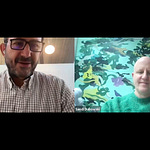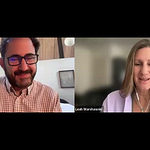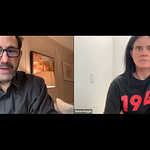Two weeks ago, Filmmaker Magazine’s Scott Macaulay and I hosted Keri Putnam to discuss her groundbreaking study of the audience and landscape for independent film. Here is the complete recording with bullet pointed highlights below.
The US Independent Film Audience and Landscape Study Webinar with Keri Putnam and Scott Macaulay
The former CEO of the Sundance Institute, and Walter Shorenstein Fellow at Harvard's Kennedy School, Keri Putnam’s report "US Independent Film Audience & Landscape" analyzes the current state of independent film in the United States, highlighting both the challenges and opportunities within the industry.
In our webinar with Keri, we delved into the complex, often fraught landscape of independent film distribution. Her work offers a comprehensive diagnosis of the challenges facing independent filmmakers today, and potential strategies for sustainable change. We explored how the system has fractured, where opportunities lie, and why understanding the audience is critical to reshaping the field. The following key takeaways include major themes discussed, as well as direct quotes from our webinar discussion.
Key Takeaways:
Fragmentation and Data Transparency:
Independent filmmakers, distributors, and producers are operating in isolated silos. While each segment of the industry grapples with its own issues, there is little cross-sector communication or data sharing.
Transparency remains a major hurdle. Sales agents, niche platforms, and even streamers or distributors are hesitant to share subscriber numbers or specific data. Without transparency, it’s hard to know the real value of comparable work and where solutions and opportunities exist.
Efforts to achieve data transparency have existed for over a decade — with advocates like Sundance pushing for change — but secrecy persists due to fear of revealing underperformance, and also due to structural limitations of comparing data sets based on how films are financed.
"There’s still a lot of reticence because people don't want to be perceived as not having succeeded with their film or be defined by a number." ~ Putnam
Without owning audience data, indie filmmakers miss out on long-term relationships and marketing opportunities.
"If you can only reach your audience through those big companies, you’re never going to really get detailed [data]. And owning that audience data is what’s key." ~ Putnam
Streaming’s Double-Edged Sword:
The rise of streaming initially brought hope to the indie sector, but competition and consolidation between streamers quickly shifted priorities to mass-market content.
Streaming giants like Netflix, Amazon, and Disney+ invested heavily in independent films during their growth phase to build libraries, but once they reached scale, their focus moved to blockbuster content.
Traditional distribution windows (theatrical, home entertainment, pay TV) collapsed under the pressure of streaming’s dominance. Transactional VOD (TVOD) and ad supported streaming platforms (AVOD) offer minimal financial returns, making it difficult for filmmakers to recoup costs.
Streaming platforms initially opened doors for indie films, but those doors have been closing as their priorities shift to blockbusters. The result? A system where the odds are stacked against indie filmmakers.
Audience Knowledge Gap:
Many filmmakers lack an understanding of who their audiences are, how they consume films, and where they watch them. This disconnect hinders the effectiveness of distribution strategies. (see the data points above that indicate a structural problem)
Putnam’s research identified a striking disparity: the potential audience for independent films exceeds 70 million people, yet only around 36 million are actively engaged.
The industry has not sufficiently invested in audience research. Institutions and individual filmmakers alike often focus more on production, and less on cultivating demand.
"There was a real overall lack of understanding of the audience and what the demand for the work was." ~ Putnam
Let’s be real: if you don’t know your audience, you can’t connect with them. There’s significant untapped potential in the existing mailing lists of theaters and festivals. Filmmakers need to think beyond the “if we build it, they will come” mentality and get strategic. But initiatives could also help collate this data.
The Problem of Data Asymmetry:
Large platforms possess vast amounts of granular audience data, enabling them to make strategic decisions. Independent filmmakers, however, lack access to this data, putting them at a disadvantage as they seek to value their work or identify audiences.
Platforms like Netflix provide minimal insight beyond the top 10 titles, leaving smaller films’ performance opaque.
“You can’t accurately value your content if you don’t know who watched movies that are like yours.” ~Putnam
Systemic Solutions:
Alternative Streamers:
Putnam mentioned the possibility of creating a collective platform for independent financiers, distributors, and filmmakers to aggregate audiences, share data, and enhance discoverability.
By pooling resources, indie stakeholders could create a more powerful distribution network than working individually.
"Doing that together is far more efficient than doing it separately."~Putnam
Get this webinar and all other webinars - become a paid subscriber.
Policy Change:
Public funding, similar to European models, could support independent storytelling, and counterbalance profit-driven monopolies.
Advocating for carve outs for independent film in state tax credit would be a great first step.
Collective Marketing:
Theaters and festivals often have mailing lists and social followings four times the size of their actual attendees, representing untapped potential. It’s time to get scrappy. Leverage those email lists, and connect with audiences who are already leaning in.
Invest in marketing tools for arthouse theaters and festivals could boost audience engagement to boost this capacity.
The gap between audience potential and actual attendance could be narrowed through smarter, data-driven marketing.
Bright Spots and Opportunities:
Kanopy leads in distributing independent films through libraries and schools, providing widespread access for curious audiences.
Letterboxd is evolving into a critical community for film discovery and curation, with the potential to integrate VOD services.
Free streaming platforms like Tubi offer robust indie verticals, particularly for Black and LGBTQ+ audiences, though they suffer from low per-title revenue.
"Tubi has incredible indie film verticals ... free streaming has done something to make it very convenient for people to find a wide array of stuff."~Putnam
While independent filmmakers may not have access to decentralized data sets or tools to gauge audience demand or stress-test distribution strategies before going to market, there are still effective ways to build and discover a film’s audience: by studying what has worked in the market and fostering community engagement.
Conclusion:
Keri Putnam’s research is a major wake-up call. It’s one of the most comprehensive studies of the potential audience for independent film distribution and the current states of film distribution that we’ve seen, and it lands at a crucial time. The challenges (monopolies, data opacity, fractured systems) are real, but they can be tackled.
This isn’t just another industry report. It’s a roadmap for indie filmmakers to reclaim their power. The audience is out there, waiting to connect. The question is: how do we reach them in a way that’s sustainable, strategic, and equitable?
We need to adapt, get creative, and fight for the future of independent film.
It’s time to dig deep, innovate and advocate.
You can read Keri Putnam’s full report here.










